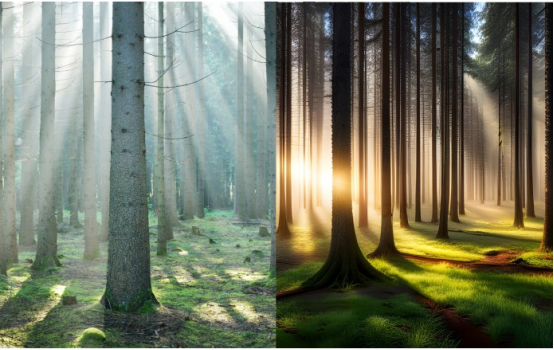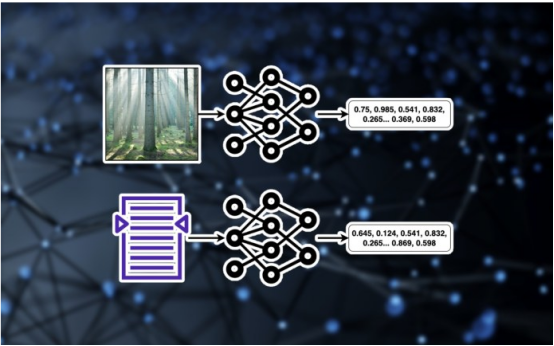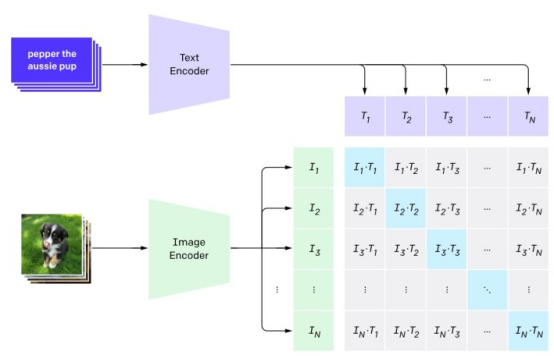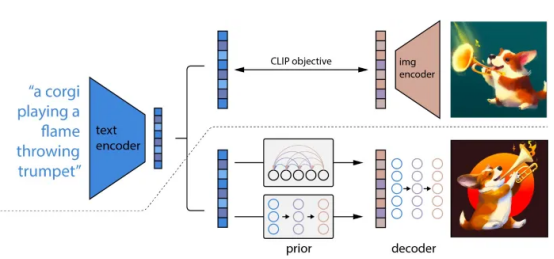How generative AI is redefining image search
To rewrite the content without changing the original meaning, the language needs to be rewritten into Chinese, and the original sentence does not need to appear
Review | The content of Chonglou needs to be rewritten
Generative artificial intelligence has attracted considerable interest in recent months with its ability to create unique text, sounds and images. However, the potential of generative AI is not limited to creating new data
The underlying techniques of generative AI (such as Transformers and diffusion models) can power many other applications, including Information search and discovery. In particular, generative AI could revolutionize image search, allowing people to browse visual information in ways that were previously impossible

Here’s what people need What you need to know about how generative AI is redefining the image search experience.
Image and text embedding
Traditional image search methods rely on text descriptions, tags, and other metadata accompanying images, which puts users The search options are limited to information that has been explicitly attached to the image. People uploading images must carefully consider the type of search queries they enter to ensure their images are discoverable by others. When searching for images, users seeking information must try to imagine what kind of description the image uploader might have added to the image
As the saying goes, "a picture is worth a thousand words." However, there are limits to what can be written about image descriptions. Of course, this can be described in many ways depending on how people view the image. People sometimes search based on the objects in the picture, and sometimes they search based on features such as style, light, location, etc. Unfortunately, images are rarely accompanied by such rich information. Many people upload many images with little to no information attached, making them difficult to discover in searches.
Artificial intelligence image search plays an important role in this regard. There are many approaches to AI image search, and different companies have their own proprietary technologies. However, there are also technologies that are jointly owned by these companies
Artificial intelligence image search and many other deep learning systems have embeddings at their core. Embedding is a method of numerical representation of different data types. For example, a 512×512 resolution image contains approximately 260,000 pixels (or features). Embedding models learn low-dimensional representations of visual data by training on millions of images. Image embedding can be applied in many useful areas, including image compression, generating new images, or comparing the visual properties of different images. The same mechanism applies to other forms such as text. Text embedding models are low-dimensional representations of the content of text excerpts. Text embeddings have many applications, including similarity search and retrieval enhancement for large language models (LLMs).
How Artificial Intelligence Image Search Works
However, when image and text embeddings are trained together , things get even more interesting. Open source datasets like LAION contain millions of images and their corresponding text descriptions. When text and image embeddings on these image/caption pairs are jointly trained or fine-tuned, they learn the association between visual and textual information. This is the idea behind deep learning techniques such as Contrastive Image Language Pretraining (CLIP).
Contrastive Image Language Pre-trained (CLIP) model learns joint embedding of text and images
 Now, we have Tool for converting text into visual embeddings. When we feed this joint model a text description, it generates text embeddings and corresponding image embeddings. We can then compare the image embeddings with images in the database and retrieve the most relevant ones. This is the basic principle of artificial intelligence image search. Registered in metadata. You can use rich search terms that were not possible before, such as "Lush green forest shrouded in morning mist, bright sunshine filtering through the tall pine forest, and some mushrooms growing on the grass."
Now, we have Tool for converting text into visual embeddings. When we feed this joint model a text description, it generates text embeddings and corresponding image embeddings. We can then compare the image embeddings with images in the database and retrieve the most relevant ones. This is the basic principle of artificial intelligence image search. Registered in metadata. You can use rich search terms that were not possible before, such as "Lush green forest shrouded in morning mist, bright sunshine filtering through the tall pine forest, and some mushrooms growing on the grass."
In the example above, the AI search returned a set of images whose visual characteristics matched this query. Many of the text descriptions do not contain the query keywords. But their embedding is similar to that of queries. Without AI image search, finding the right image would be much more difficult.
From Discovery to Creation
Sometimes, the image people are looking for doesn’t exist, and even an AI search can’t find it. In this case, generative AI can help users achieve desired outcomes in one of two ways.
First, we can create a new image from scratch based on the user’s query. This approach involves using a text-to-image generative model (such as Stable Diffusion or DALL-E) to create an embedding for the user's query and leveraging that embedding to generate the image. Generative models utilize joint embedding models such as Contrastive Image Language Pretraining (CLIP) and other architectures such as Transformers or Diffusion models to convert embedded numerical values into stunning images
 DALL-E uses Contrastive Image Language Pre-training (CLIP) and diffusion to generate images from text
DALL-E uses Contrastive Image Language Pre-training (CLIP) and diffusion to generate images from text
The second method is to leverage existing images and use the generated ones according to personal preference model for editing. For example, in an image showing a pine forest, mushrooms are missing from the grass. Users can choose a suitable image as a starting point and add mushrooms to it via a generative model.

Generative AI creates a whole new paradigm , blurring the lines between discovery and creativity. And within a single interface, users can find images, edit images, or create entirely new images.
Original title: How generative AI is redefining image search, by Ben Dickson
The above is the detailed content of How generative AI is redefining image search. For more information, please follow other related articles on the PHP Chinese website!

Hot AI Tools

Undresser.AI Undress
AI-powered app for creating realistic nude photos

AI Clothes Remover
Online AI tool for removing clothes from photos.

Undress AI Tool
Undress images for free

Clothoff.io
AI clothes remover

Video Face Swap
Swap faces in any video effortlessly with our completely free AI face swap tool!

Hot Article

Hot Tools

Notepad++7.3.1
Easy-to-use and free code editor

SublimeText3 Chinese version
Chinese version, very easy to use

Zend Studio 13.0.1
Powerful PHP integrated development environment

Dreamweaver CS6
Visual web development tools

SublimeText3 Mac version
God-level code editing software (SublimeText3)

Hot Topics
 1386
1386
 52
52
 Bytedance Cutting launches SVIP super membership: 499 yuan for continuous annual subscription, providing a variety of AI functions
Jun 28, 2024 am 03:51 AM
Bytedance Cutting launches SVIP super membership: 499 yuan for continuous annual subscription, providing a variety of AI functions
Jun 28, 2024 am 03:51 AM
This site reported on June 27 that Jianying is a video editing software developed by FaceMeng Technology, a subsidiary of ByteDance. It relies on the Douyin platform and basically produces short video content for users of the platform. It is compatible with iOS, Android, and Windows. , MacOS and other operating systems. Jianying officially announced the upgrade of its membership system and launched a new SVIP, which includes a variety of AI black technologies, such as intelligent translation, intelligent highlighting, intelligent packaging, digital human synthesis, etc. In terms of price, the monthly fee for clipping SVIP is 79 yuan, the annual fee is 599 yuan (note on this site: equivalent to 49.9 yuan per month), the continuous monthly subscription is 59 yuan per month, and the continuous annual subscription is 499 yuan per year (equivalent to 41.6 yuan per month) . In addition, the cut official also stated that in order to improve the user experience, those who have subscribed to the original VIP
 Context-augmented AI coding assistant using Rag and Sem-Rag
Jun 10, 2024 am 11:08 AM
Context-augmented AI coding assistant using Rag and Sem-Rag
Jun 10, 2024 am 11:08 AM
Improve developer productivity, efficiency, and accuracy by incorporating retrieval-enhanced generation and semantic memory into AI coding assistants. Translated from EnhancingAICodingAssistantswithContextUsingRAGandSEM-RAG, author JanakiramMSV. While basic AI programming assistants are naturally helpful, they often fail to provide the most relevant and correct code suggestions because they rely on a general understanding of the software language and the most common patterns of writing software. The code generated by these coding assistants is suitable for solving the problems they are responsible for solving, but often does not conform to the coding standards, conventions and styles of the individual teams. This often results in suggestions that need to be modified or refined in order for the code to be accepted into the application
 Can fine-tuning really allow LLM to learn new things: introducing new knowledge may make the model produce more hallucinations
Jun 11, 2024 pm 03:57 PM
Can fine-tuning really allow LLM to learn new things: introducing new knowledge may make the model produce more hallucinations
Jun 11, 2024 pm 03:57 PM
Large Language Models (LLMs) are trained on huge text databases, where they acquire large amounts of real-world knowledge. This knowledge is embedded into their parameters and can then be used when needed. The knowledge of these models is "reified" at the end of training. At the end of pre-training, the model actually stops learning. Align or fine-tune the model to learn how to leverage this knowledge and respond more naturally to user questions. But sometimes model knowledge is not enough, and although the model can access external content through RAG, it is considered beneficial to adapt the model to new domains through fine-tuning. This fine-tuning is performed using input from human annotators or other LLM creations, where the model encounters additional real-world knowledge and integrates it
 Seven Cool GenAI & LLM Technical Interview Questions
Jun 07, 2024 am 10:06 AM
Seven Cool GenAI & LLM Technical Interview Questions
Jun 07, 2024 am 10:06 AM
To learn more about AIGC, please visit: 51CTOAI.x Community https://www.51cto.com/aigc/Translator|Jingyan Reviewer|Chonglou is different from the traditional question bank that can be seen everywhere on the Internet. These questions It requires thinking outside the box. Large Language Models (LLMs) are increasingly important in the fields of data science, generative artificial intelligence (GenAI), and artificial intelligence. These complex algorithms enhance human skills and drive efficiency and innovation in many industries, becoming the key for companies to remain competitive. LLM has a wide range of applications. It can be used in fields such as natural language processing, text generation, speech recognition and recommendation systems. By learning from large amounts of data, LLM is able to generate text
 Five schools of machine learning you don't know about
Jun 05, 2024 pm 08:51 PM
Five schools of machine learning you don't know about
Jun 05, 2024 pm 08:51 PM
Machine learning is an important branch of artificial intelligence that gives computers the ability to learn from data and improve their capabilities without being explicitly programmed. Machine learning has a wide range of applications in various fields, from image recognition and natural language processing to recommendation systems and fraud detection, and it is changing the way we live. There are many different methods and theories in the field of machine learning, among which the five most influential methods are called the "Five Schools of Machine Learning". The five major schools are the symbolic school, the connectionist school, the evolutionary school, the Bayesian school and the analogy school. 1. Symbolism, also known as symbolism, emphasizes the use of symbols for logical reasoning and expression of knowledge. This school of thought believes that learning is a process of reverse deduction, through existing
 To provide a new scientific and complex question answering benchmark and evaluation system for large models, UNSW, Argonne, University of Chicago and other institutions jointly launched the SciQAG framework
Jul 25, 2024 am 06:42 AM
To provide a new scientific and complex question answering benchmark and evaluation system for large models, UNSW, Argonne, University of Chicago and other institutions jointly launched the SciQAG framework
Jul 25, 2024 am 06:42 AM
Editor |ScienceAI Question Answering (QA) data set plays a vital role in promoting natural language processing (NLP) research. High-quality QA data sets can not only be used to fine-tune models, but also effectively evaluate the capabilities of large language models (LLM), especially the ability to understand and reason about scientific knowledge. Although there are currently many scientific QA data sets covering medicine, chemistry, biology and other fields, these data sets still have some shortcomings. First, the data form is relatively simple, most of which are multiple-choice questions. They are easy to evaluate, but limit the model's answer selection range and cannot fully test the model's ability to answer scientific questions. In contrast, open-ended Q&A
 SOTA performance, Xiamen multi-modal protein-ligand affinity prediction AI method, combines molecular surface information for the first time
Jul 17, 2024 pm 06:37 PM
SOTA performance, Xiamen multi-modal protein-ligand affinity prediction AI method, combines molecular surface information for the first time
Jul 17, 2024 pm 06:37 PM
Editor | KX In the field of drug research and development, accurately and effectively predicting the binding affinity of proteins and ligands is crucial for drug screening and optimization. However, current studies do not take into account the important role of molecular surface information in protein-ligand interactions. Based on this, researchers from Xiamen University proposed a novel multi-modal feature extraction (MFE) framework, which for the first time combines information on protein surface, 3D structure and sequence, and uses a cross-attention mechanism to compare different modalities. feature alignment. Experimental results demonstrate that this method achieves state-of-the-art performance in predicting protein-ligand binding affinities. Furthermore, ablation studies demonstrate the effectiveness and necessity of protein surface information and multimodal feature alignment within this framework. Related research begins with "S
 SK Hynix will display new AI-related products on August 6: 12-layer HBM3E, 321-high NAND, etc.
Aug 01, 2024 pm 09:40 PM
SK Hynix will display new AI-related products on August 6: 12-layer HBM3E, 321-high NAND, etc.
Aug 01, 2024 pm 09:40 PM
According to news from this site on August 1, SK Hynix released a blog post today (August 1), announcing that it will attend the Global Semiconductor Memory Summit FMS2024 to be held in Santa Clara, California, USA from August 6 to 8, showcasing many new technologies. generation product. Introduction to the Future Memory and Storage Summit (FutureMemoryandStorage), formerly the Flash Memory Summit (FlashMemorySummit) mainly for NAND suppliers, in the context of increasing attention to artificial intelligence technology, this year was renamed the Future Memory and Storage Summit (FutureMemoryandStorage) to invite DRAM and storage vendors and many more players. New product SK hynix launched last year




